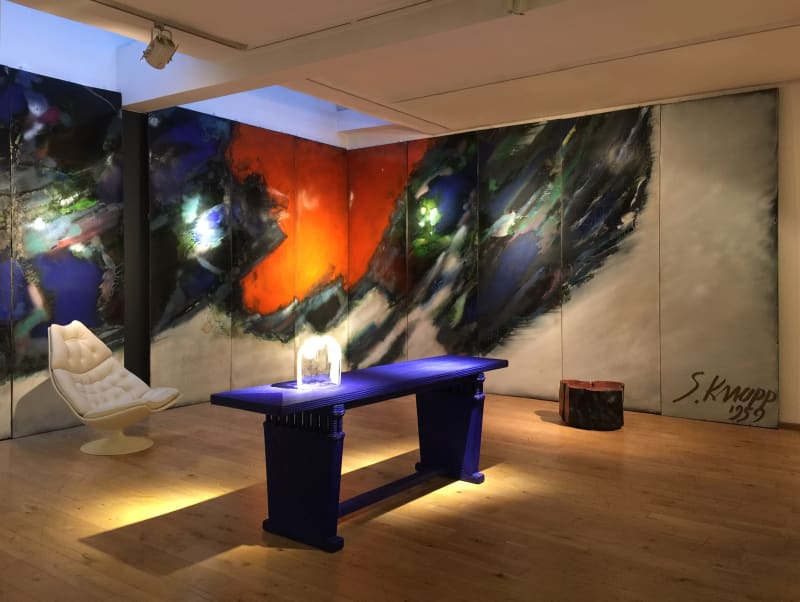Monumental in conception and unprecedented in scale, Stefan Knapp's largest mural for Heathrow Airport has become available following the closure of Terminal 1.
A survivor of a Siberian gulag, Spitfire and reconnaissance pilot, author (and sometime ski instructor), Stefan Knapp was born in southeast Poland. Following the outbreak of WWII he was arrested by the Soviets while still a teenager and interned in a labour camp, looking at a five year sentence. In 1941 the Sikorski-Mayski agreement saw the release of Polish prisoners of war, enabling Knapp to make his way to Great Britain where he trained with the RAF. He flew successful sorties over Egypt and Palestine and was decorated for his services.
Following the war and remaining in England, Knapp studied at the Central School of Arts in London and then at the Slade. War experiences gave rise to nightmares and insomnia from which Knapp was to find a degree of release in his art. He explored various media, experimenting with the potential of enamelling in the 1950s. Hanover Gallery's, London, first exhibition of Knapp's remarkable compositions in 1954 garnered a very favourable review in Time magazine and commissions ensued. This critical solo show presented Knapp's abstract painting-sculpture, for the first time now realised in a new technique he discovered whereby enamel could be fixed to zero carbon steel instead of its traditional base, copper.
The commission of a series of murals for Heathrow Airport employed this technological breakthrough to spectacular effect. Cathy, Knapp's wife, described the process in 1999 in Glass on Metal magazine: "[he] cleaned the steel chemically, then washed it and quickly sprayed it with a cobalt enamel grip coat. This was a pale grey biscuit color before firing but after an initial firing at 820 degrees centigrade became a shiny black color. He then poured a coating of opaque white enamel over the panel and when it was dry would draw his cartoon, sgraffito style."
The abstract, vibrant diagonal splashes and slashes of colour over a sequence of flat planes speak, it has been suggested, to aerial landscape and topography which occupied Knapp during his photographic reconnaissance missions in WWII.
Commissioned in 1958 and initially installed on the facade of Terminal 3, the Heathrow murals are the mature expression of Knapp's triangular preoccupation with painting, enamel and sculpture. His pursuit of pure colour and constant experimentation were a perfect fit for works in enamel - borne out by the murals enjoyed for decades by travellers passing through the airport.
Another successful show, this time in 1957 at Pierre Matisse Gallery, New York City, introduced Knapp's work Stateside. George Farkas, an art collector and and owner of Alexander's department store chain, subsequently saw Knapp's murals at Heathrow and commissioned him to create a massive mural (280 panels which weighed 250 tons - urban legend has it that it also served as a landmark for incoming flights to JFK airport) for his flagship store in New Jersey in 1961. Archival footage exists of Knapp 'skiing' across the panels laid out on the floor to apply the enamel paints.
The mural proved extremely popular and prompted Farkas to commission artwork for his Manhattan store exterior. Salvador Dalí was the artist of choice. He proposed a zany scheme including giraffes overhanging the street with department store drawers dangling from their necks. Knapp was consulted and Dalí suggested the Polish-born artist could enamel the animals. Knapp declined and the entire commission was transferred to him solely. The resulting Op Art joyous pattern of colourfully enamelled steel domes branded Alexander's in several New York locations.
Worldwide acclaim encouraged Knapp to complete a frantic schedule of commissions and exhibitions until his death in 1996 - just two days after overseeing a selection of his Heathrow murals re-finished and re-installed in the Richard Rogers Transit Building at the airport. Caracas, Holland, Austria, Peru, Japan, Mexico, Guatemala, … - the locations where Knapp presented his art are nigh on endless. But home was with his wife, Cathy, in the British countryside, where he continued to paint to the end.
EXHIBITIONS:
1999 Stefan Knapp, Whitford Fine Art, London, UK (solo)
1994 Mèru, France (solo)
1990 Polonia Palace, Warsaw, Poland (solo)
1987 San Jose Museum of Art, USA (solo)
1986 Grabowsky Gallery II, London, UK (solo)
1984 Municipal Museum, Bordeaux, France (solo)
1982 Harttor Gallery, Germany (solo)
1980 Crane Kalman Gallery, London, UK (solo)
1979 Galerie D'Eent, Amsterdam, The Netherlands (solo)
1974 Galeria Zacheta Palace, Warsaw, Poland (solo)
1974 Rutland Gallery, London, UK (solo)
1973 Galerie D'Eent, Amsterdam, The Netherlands (solo)
1973 Estudo Actual, Caracas, Venezuela (solo)
1968 Galerie D'Eent, Amsterdam, The Netherlands (solo)
1968 Galerie Gunter Franke, Munich, Germany (solo)
1967 Hanover Gallery, London, UK (solo)
1967 USIS Gallery, London, UK (solo)
1966 Detroit Arts Institute, Detroit, USA (solo)
1965 Hanover Gallery, London, UK (solo)
1965 Kalman Gallery, Manchester, UK (solo)
1964 Hanover Gallery, London, UK (solo)
1964 Hella Nebelung Galerie, Dusseldorf, Germany (solo)
1963 Neue Galerie der Stadt, Linz, Austria (solo)
1963 Galerie Gunter Franke, Munich, Germany (solo)
1962 Instituto de Arte Contemporaneo, Lima, Peru (solo)
1962 Galeria ZPAP, Warsaw Poland (solo)
1961 Museo de Arte Moderna, Buenos Aires, Argentina (solo)
1960 USIS Gallery, London, UK (solo)
1960 Museo de Bellas Artes, Caracas, Venezuela (solo)
1959 Prima Lissone, Milan, Italy (solo)
1959 International Choice, London, UK (solo)
1959 Hanover Gallery, London, UK (solo)
1958 Galerie de Art Contemporaneo, Caracas, Venezuela (solo)
1957 Prima Lissone, Milan, Italy (solo)
1957 Prima Matisse Gallery, London, UK (solo)
1956 Hanover Gallery, London, UK (solo)
1955 Tooth Gallery, London, UK (solo)
1954 Hanover Gallery, London, UK (solo)
1947 London Gallery, London, UK (solo)
